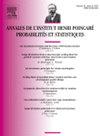定向聚合物在γ稳定随机环境中的应用
IF 1.6
2区 数学
Q2 STATISTICS & PROBABILITY
Annales De L Institut Henri Poincare-probabilites Et Statistiques
Pub Date : 2021-05-01
DOI:10.1214/20-AIHP1108
引用次数: 6
摘要
定向聚合物在随机环境中从弱无序相(扩散相)到强无序相(定域相)的转变是一个很好的研究现象。在最常见的设置中,当横向维d = 1或2时(扩散相降为β=0),相变是平凡的,而当d≥3时,存在一个临界温度βc∈(0,∞)将两相划分开来。对d≥3时扩散区存在性的证明是基于二阶矩法(Comm. Math)。物理学报,123(1989):529-534。Probab. 34 (2006) 1746-1770, J. Stat. Phys. 52(1988) 609-626),因此在很大程度上依赖于这样一个假设,即编码无序强度的变量(在大多数数学文献中假设为eβηx的形式)具有有限的第二矩。这项工作的目的是研究在无序变量显示较重尾部的情况下,相变的存在/不存在如何取决于维d。为此,我们将eβηx替换为(1+βωx),其中ωx在参数γ∈(1,2)的稳定定律的吸引域内。在这种情况下,我们证明当且仅当γ>1+2/d时发生非平凡相变。更确切地说,当γ≤1+2/d时,系统在每个温度下的自由能都小于其退火后的系统,而当γ>1+2/d时,重整配分函数的鞅序列收敛于所有足够小的β几乎肯定是正的随机变量。本文章由计算机程序翻译,如有差异,请以英文原文为准。
Directed polymer in γ-stable random environments
The transition from a weak-disorder (diffusive) to a strong-disorder (localized) phase for directed polymers in a random environment is a well studied phenomenon. In the most common setup, it is established that the phase transition is trivial when the transversal dimension d equals 1 or 2 (the diffusive phase is reduced to β=0) while when d≥3, there is a critical temperature βc∈(0,∞) which delimits the two phases. The proof of the existence of a diffusive regime for d≥3 is based on a second moment method (Comm. Math. Phys. 123 (1989) 529–534, Ann. Probab. 34 (2006) 1746–1770, J. Stat. Phys. 52 (1988) 609–626), and thus relies heavily on the assumption that the variable which encodes the disorder intensity (which in most of the mathematics literature assumes the form eβηx), has finite second moment. The aim of this work is to investigate how the presence/absence of phase transition may depend on the dimension d in the case when the disorder variable displays a heavier tail. To this end we replace eβηx by (1+βωx) where ωx is in the domain of attraction of a stable law with parameter γ∈(1,2). In this setup we show that a non-trivial phase transition occurs if and only if γ>1+2/d. More precisely, when γ≤1+2/d, the free energy of the system is smaller than its annealed counterpart at every temperature whereas when γ>1+2/d the martingale sequence of renormalized partition functions converges to an almost surely positive random variable for all β sufficiently small.
求助全文
通过发布文献求助,成功后即可免费获取论文全文。
去求助
来源期刊
CiteScore
2.70
自引率
0.00%
发文量
85
审稿时长
6-12 weeks
期刊介绍:
The Probability and Statistics section of the Annales de l’Institut Henri Poincaré is an international journal which publishes high quality research papers. The journal deals with all aspects of modern probability theory and mathematical statistics, as well as with their applications.

 求助内容:
求助内容: 应助结果提醒方式:
应助结果提醒方式:


